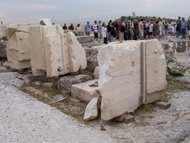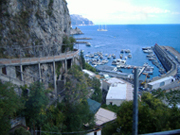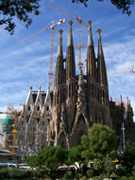Here’s a toast to all the trekkers who travel the world seeking trails tromped smooth or rutted by thousands of tourists.
My wife Leigh and I booked a 14-day Mediterranean cruise with a week to get acclimated in Cambridge, England, at her son John and daughter-in-law’s home. My first observed stones were in John’s driveway: very intriguing finger-sized, coarse ocher rind with black-gray interior loose flint nuggets. All the ancient buildings and walks in Cambridge are of stone. The details were overwhelming, to the point where the first hour’s viewing saturated the mind’s ability to absorb anymore. The variety of stone and techniques seen on daytrips to Ely and its cathedral (wow), Blenheim Palace, and Audley End were refreshing. There can be quite a variance in stone fence types along the various country roads.
Venice was the departure port for the cruise, and we booked a hotel on the Grand Canal a day ahead. The day and a half allowed by the cruise line isn’t enough for Venice! Put on your walking shoes, as there isn’t any land transportation. A sunny day and a casual cruise by vaporetto (water bus) to Peggy Guggenheim’s museum (a must-see) put the old mansions on display, in all their sinking glory. Old main entrances are awash with the waves of the canal. Crumbling plaster reveals the stonework beneath. Repair/renovation costs are prohibitive, so the decline continues. St. Mark’s Basilica and the Doge’s palace stretch the comprehension of the novice tourist. The multicolored columns of the Basilica are especially striking with their polished surfaces and veining. How were they made so many years ago?
Dubrovnik was fascinating. Include it in your itinerary if you can. Marble paving blocks worn smooth over the centuries were very slippery in the misty rain. Unfurled umbrellas added to the threat of milling tourist groups. I saw a large two-man hand cart loaded with beautiful limestone balusters for some repair project.

An overcast sky and a bit of smog greeted us in Piraeus/Athens. A long trek through the port to #16 of 40-plus buses started the tour to the Acropolis and the ancient ruins that are so famous. Only 150 steps in a winding path up to the Parthenon: ramped flagstones of various sizes, adjusted to fit the hill’s natural exposed marble surface. Toppled columns and stones litter the area; most have been arranged in sequence to allow fabrication of pieces to recreate the original structures. Cranes, saws, and workers with angle grinders compete with scaffolding to distract the viewer from full appreciation of the experience. Close observance of some of the construction show that metal ties were used to splice stones together. Bumps and dimples were also used (I’ll bet there is an engineering term for these). The illusions of straightness created by the slightly-bulging columns and humping of slabs were interesting to see first-hand.
Kusadasi, Turkey was next, with another long tour into the hinterlands and another good guide to Ephesus, Miletus, and Didyma. All are ancient Roman ruins, but Ephesus is the most excavated and facinating. Out in the country towns there are stores with yards full of marble slabs and blocks. After trooping around old ruins all day, I bought some postcards and observed Apollo’s Temple from the patio of the bar across the street with a nice cold beer in hand.
Naples was the start of another bus tour to Sorrento and the Amalfi Coast - picturesque, to say the least. Get on the right side of the bus if you want the best viewing. Cliff hanging estates and towns, cantilevered roads, and terraced vineyards and olive groves make one marvel at the tenacity of the residents.
Rome access starts in the port city of Civitavecchia, and is ninety minutes away. With 3 million people, there is heavy traffic, and time lost in transit has to be made up by shortened tour and shopping time. With potty stops for forty old people, time can become a hassle. There’s lots to see: St. Peter’s Square (Bernini’s 100+ statues around the rim seem like more than a lifetime’s work: who helped him?), the Vatican Museum (you’ll need at least three days), St. Peter’s Basilica (the Pieta is behind glass 20 feet away; it could have been plastic), Pantheon, Trevi Fountain, Spanish Steps. We did the last three in a mad dash through the city in a hired cab. And of course there are all the old ruins.
A relaxing country tour the next day to an old walled town (Tuscania) presented yet another old Roman remnant still inhabited. Automatic pylons controlled by key card, first seen in Cambridge to control access to downtown, regulated residents’ comings and goings. No big cars or trucks. More stone walls and cobbled streets, worn and grooved. An enjoyable lunch of typical Italian fare at a working farm was a nice break in the bustle of the last few days. Sunshine, olive groves, an orchard, and two frolicking kittens provided ambience. The wine helped, too.
Livorno, the port city for Florence and Pisa (which used to be the port centuries ago), had ancient fortifications right in the harbor. I was afraid to risk a non-cruise sponsored tour to Carrara, so opted for a sight seeing tour to Cinque Terre. It was just as well, as the quarries were closed to visitors while some movie is being made. The old towns clinging to the cliffs were fantastic. We saw four of the five famous villages, via foot and train. Stone is used for walls, walks, bridges, forts, and castles. A lot of the old defensive towers have been taken over by entrepreneurs for restaurants and shops. Returning to port the quarries of Carrara were shining in the sun ten miles away. There were huge marble storage yards and fabricating facilities along the highway by Pietrasanta. The leaning Tower of Pisa was visible across the flat landscape, about an eighth of an inch high at arm’s length.
Villefranche, the gateway to Monte Carlo and Nice, is one of the most picturesque harbors anywhere. Too small for the cruise ships, tenders are used to shuttle tourists ashore. The Citadel, an old fortification made into a museum, is another must-see. A tour to St. Paul de Vence, an ancient walled city, via Nice (crowded, narrow streets, nice beach avenue) was the highlight of the tour for me. High on a hill (500 yards uphill from the bus), and protected from intruders by automatic pylons, I’ve never seen so many high-end galleries and shops in one place, crowded along narrow walkways going over the hill, and stairways across it. Being close to the money along the French Riviera certainly provides a sales opportunity. It’s hard to imagine supplying frames and sculptures to the artists and galleries there. The Maeght Museum, a private museum with indoor and outdoor gardens housing great sculptures of Miro, Chagall, Giacometti, and others, was another 600 yards uphill. It was definitely worth the hike and price of admission.
Barcelona: our last port. Unfortunately we only had time for a quick morning tour before catching a plane home. Traffic doesn’t exist on Saturday morning, so we had easy traveling. We missed the Gaudi park, but saw some of his buildings and the Sagrada Familia. The Santa Eulalia Cathedral is an amazing old structure built before the advent of the flying buttress. Its flock of thirteen geese is rooted in history. The stone mosaics of the plaza at Montjuic Park are very pleasing, and the view of the city is vast. If you take a similar cruise, schedule an extra day so you can see beautiful Barcelona without the rush.
Having seen enough ancient ruins and statues to last the rest of my life, my easy chair at home was a welcome sight.

